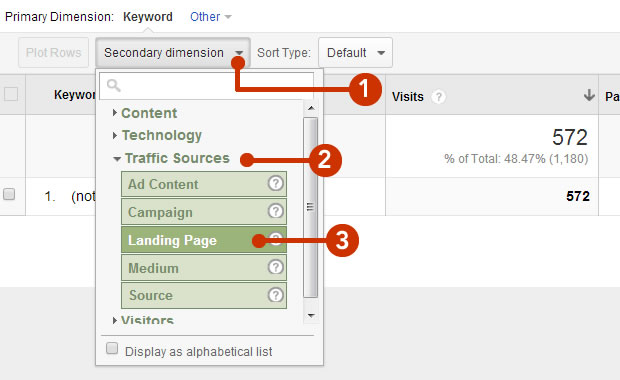Gain Comprehensive Viewpoints With Secondary Measurement in Google Analytics
Additional measurements in Google Analytics act as an effective tool for improving the deepness of understandings derived from data analysis. Keep tuned to uncover how additional dimensions can transform your data analysis and drive notified decision-making in the digital world.
Understanding Secondary Measurements in GA
The principle of second dimensions in Google Analytics enhances information evaluation by supplying extra insights right into main metrics. Secondary dimensions permit individuals to dig deeper right into their information by including an additional layer of information to the key information being examined. By incorporating second measurements, users can sector and compare data throughout different measurements, such as website traffic sources, user tools, geographical places, and much more. This extra level of granularity allows a much more detailed understanding of user habits and internet site efficiency.
Comprehending just how to effectively use additional measurements in Google Analytics is necessary for extracting useful understandings from the data gathered. By picking the appropriate additional measurements to enhance primary metrics, individuals can reveal patterns, trends, and connections that might have or else gone unnoticed. This deeper degree of evaluation can result in even more informed decision-making and the optimization of electronic advertising methods to boost overall performance.
Benefits of Utilizing Additional Measurements
Discovering the benefits fundamental in leveraging additional measurements within Google Analytics brightens the deepness of understandings readily available for enhancing data evaluation. By including second dimensions, individuals can get an extra extensive understanding of their key data metrics. Among the key advantages is the capacity to sector and filter data, permitting a much more thorough analysis of specific dimensions such as website traffic sources, individual actions, or geographical location - Secondary Dimension in Google Analytics. This division assists in recognizing patterns, trends, and connections that could not be obvious when considering the data in seclusion.
Moreover, second dimensions enable customers to compare and contrast different information points within the same record, supplying a more holistic sight of internet site efficiency. This relative analysis can clarify the performance of advertising and marketing campaigns, web content interaction, or user demographics. In addition, the usage of secondary measurements can assist in determining outliers or abnormalities that may call for more examination.
Essentially, leveraging secondary dimensions in Google Analytics supplies an effective device for removing useful understandings and enhancing data-driven decision-making procedures.
Implementing Secondary Measurements Effectively
To successfully carry out second dimensions in Google Analytics, strategizing the choice and application of these added data layers is vital for maximizing the depth of understandings stemmed from analytics reports. When selecting second dimensions, think about the specific goals of your evaluation to make certain the chosen measurements line up with the information needed to address essential inquiries. It's important to focus on significance over amount, picking dimensions that match the key measurement and provide significant context.
Executing secondary measurements successfully involves using them to discover patterns, trends, and relationships that might not be evident when evaluating data entirely based on the primary dimension. By including second dimensions thoughtfully, you can improve the granularity of your analysis and gain much deeper insights right into user habits, content efficiency, and other key metrics within Google Analytics.
Studying Data With Second Measurements
Utilizing secondary measurements in information evaluation supplies a nuanced point of view that more tips here uncovers detailed connections and patterns within Google Analytics reports. By including additional dimensions along with main dimensions, experts can dig deeper right into the data to remove useful insights. When examining data solely based on key dimensions., this strategy allows the recognition of correlations that might not be right away apparent.
When analyzing data with secondary measurements in Google Analytics, it is necessary to consider the certain metrics or measurements that will certainly provide the most significant context for the main measurement being assessed. For instance, matching the main dimension of 'web traffic resource' with additional measurements such as 'tool group' or 'touchdown page' can provide a much more thorough understanding of customer actions and choices.
Moreover, the capacity to segment information using second measurements enables a more granular examination of customer communications, helping in the optimization of marketing methods, site performance, and total user experience. By leveraging secondary measurements effectively, companies can make educated choices based upon a comprehensive analysis of their Google Analytics data.
Best Practices for Second Dimensions
When executing second measurements in Google Analytics, precision in selecting pertinent metrics is vital for obtaining actionable understandings from the information analysis process. One of the very best practices for using secondary dimensions properly is to align them with your key dimension to gain an extra extensive understanding of your website or project performance. For instance, if your primary measurement is 'Source/Medium,' pairing it with second dimensions like 'Gadget Category' or 'Touchdown Web page' can offer understandings into how different gadgets or landing pages influence traffic from numerous sources.

Regularly explore different combinations of secondary and primary dimensions can assist you find new connections and fads within your information, allowing you to maximize your approaches and boost overall performance (Secondary Dimension in Google Analytics). By following these best practices, you can leverage secondary dimensions in Google Analytics efficiently to acquire deeper insights and make data-driven decisions that favorably affect your service

Conclusion
To conclude, secondary dimensions in Google Analytics offer a useful possibility to obtain deeper insights into primary data metrics. By investigate this site adding an additional dimension to reports, services can reveal relationships, fads, and patterns that might not be instantly evident, causing an extra thorough understanding of customer behavior and interactions on a site. Carrying out second dimensions efficiently and examining information with them can aid organizations make data-driven decisions and enhance their on the internet efficiency.
By including second measurements, customers can section and contrast information across various measurements, such as web traffic sources, individual gadgets, geographic places, and a lot more. Applying second measurements properly entails using them to uncover patterns, patterns, and relationships that may not be apparent when examining information exclusively based on the primary measurement. By incorporating additional dimensions alongside key dimensions, experts can dive much deeper right into the information to draw out useful understandings. One of the best techniques for using additional measurements properly is to align them with your key dimension to gain a more detailed understanding of your web site or campaign efficiency. If your key dimension is 'Source/Medium,' combining it with secondary dimensions like 'Device Classification' or 'Landing Page' can offer understandings right into exactly how various devices or landing pages impact website traffic from various resources.
 Alfonso Ribeiro Then & Now!
Alfonso Ribeiro Then & Now! Michael J. Fox Then & Now!
Michael J. Fox Then & Now! Anthony Michael Hall Then & Now!
Anthony Michael Hall Then & Now! Danica McKellar Then & Now!
Danica McKellar Then & Now! Tonya Harding Then & Now!
Tonya Harding Then & Now!